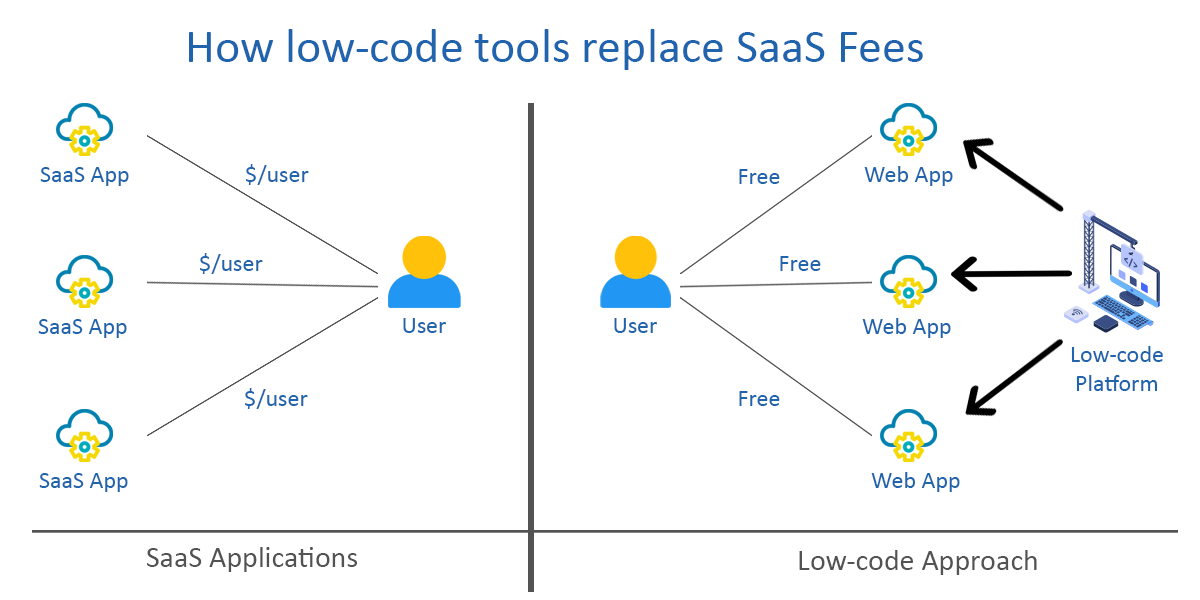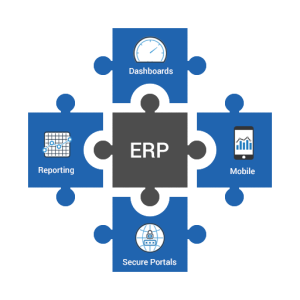![]() Summary: Low-code development is synonymous with development speed. But, did you know that development speed is just one of many ways that low-code tools can actually pay for themselves? In this article, we explain 7 different ways other companies use low-code software to pay for itself.
Summary: Low-code development is synonymous with development speed. But, did you know that development speed is just one of many ways that low-code tools can actually pay for themselves? In this article, we explain 7 different ways other companies use low-code software to pay for itself.
In this article, you’ll learn how other companies get value out of low-code platforms. In fact, low-code tools pay for themselves if you use them right.
Now, you’ve probably heard that low-code saves time. It lets you develop applications quickly, with fewer resources. Many think that the benefits stop there.
But, that’s just scratching the surface.
Low-code tools can pay for themselves many times over if you understand what’s possible. To help you out, I’ve outlined 7 different ways that low-code platforms can pay for themselves, complete with examples.
Sound good? Let’s dive right in.
1. Eliminate SaaS user fees
How many different pieces of software does your business use? Across all departments, it’s probably more than you realize.
How many Software as a Service (SaaS) applications does the average organization use? According to these statistics, the answer is 110 SaaS applications! Crazy, right?
Now, SaaS apps usually charge per user and each employee typically uses multiple applications. How much do you think the average company spends per employee on SaaS?
According to these statistics, companies spend anywhere from $2,000 – $8,500 per year on SaaS per employee. Average total SaaS costs range from $200 – $4 million per year, depending on company size.
Why am I sharing all of these SaaS statistics?
If your company uses many SaaS products, you’re in a prime position to get value from low-code tools. Smart companies use low-code to replace some of their SaaS products (and eliminate user fees) with custom applications.
Think about it. Rather than pay many sets of user fees for various SaaS apps, you can pay one set of fees for low-code. Then, you can use that low-code tool and replace some of your SaaS apps.
I know what you might be thinking: “Isn’t low-code only for basic applications?” This is a myth. Depending on the tool, low-code can easily create enterprise-class applications.
Here’s a great example of a company that used low-code to replace multiple SaaS products (and eliminate the associated user fees). They managed to replace a time-keeping application, a CRM system, an employee calendar, and more–all with custom applications.
“The applications we’ve created are key to our long-term business development,” says John McHale, Managing Director of TAG Scaffolding. “Without it our business processes would be spread over many different systems, each with their own costs and each needing their own data input.”

2. Improve time to market
Low-code platforms reduce application development time by 50 – 80%. Applications that would formerly take months only require days or weeks.
“Low-code application development tools accelerate web-app development allowing organizations to go to market faster than competitors with products that require a web interface or companion app,” says Isaac Gould, Research Manager at Nucleus Research.
The question: How does reduced time-to-market help low-code pay for itself? Here are a few examples:
Quickly meet changing business needs: When the pandemic hit and lockdowns went into effect, many companies scrambled to adapt. They needed web-based applications to keep their business running.
Which companies fared the best? Those with low-code tools. Here’s a great example of a foodservice company that adapted quickly. In response to the lockdowns, they built and rolled-out an eCommerce portal to sell their products online–all in just a few weeks. Their secret: They used low-code.
Outpace the competition: What if you just moved faster than your competitors? If you’re a software company or an organization that relies on web-based applications, that’s a huge advantage.
Deliver customer solutions faster: What if you could give customers the features they requested…right away? For instance, suppose a few customers asked for a specific feature in their customer portal. With a low-code tool, you could have it built and deployed in hours or days (depending on the complexity). While I can’t put a dollar amount on happy customers, I do know it’s great for business.
“Low code solutions enable businesses to run quick tweaks and solutions that lead to a better customer experience,” says Richa Nathani, Content Manager at Dialed Labs. “From quick updates to websites in a bid to enhance user experience to applying on-the-go changes to an e-commerce portal to enable faster checkouts, there are plenty of ways to access and put to work the advantages of low code. A happy customer buys more and recommends more, and when your brand offers a better customer experience based on the perks of low code solutions, it stands to sell more too.”
3. Avoid ERP module fees
 ERP systems are expensive. But, the costs don’t end with the initial implementation.
ERP systems are expensive. But, the costs don’t end with the initial implementation.
Let me explain: ERP systems come with basic modules built-in, each representing a specific feature. For instance, you might have a reports module, inventory module, CRM module, etc…
However, you’re paying extra if you want features that go beyond the included modules. This could be a one-time fee or a monthly per-user fee.
For instance, suppose you want the mobile or marketing module but it’s not included. You’re stuck paying for them.
The problem: It’s not cheap.
What can you do if you want the features, but don’t want to pay the additional fees?
Here’s a great example of how one company addressed this issue using low-code. Rather than pay $75,000 for an ERP mobile module, they built a custom mobile solution themselves. Using a low-code tool, they built mobile web apps that let users access real-time ERP data from any mobile device.
“We’ve consolidated our data into a secure web portal where each department can easily access the data and reports they require in seconds,” says Paul Millard, IT Manager at Renzi Foodservice. “We have utilized [low-code software] to extend capabilities of our existing Retalix ERP database—avoiding modification costs and giving us more bang for the buck.”
4. Reduce shadow IT

“Shadow IT” is a term used to describe software used inside companies without IT’s knowledge or approval.
Why does it happen?
There are a number of reasons. Maybe employees are acting maliciously. Maybe they’re knowingly trying to bypass IT. Or most likely, they’re probably just trying to meet a need that they can’t meet otherwise.
While intentions are most likely innocent, the costs are very real. Here are a few:
- Potential security risks: When employees use software that isn’t authorized by IT, they may be opening company data up to security breaches. According to this article, the average cost to fix a data breach sits around $4 million dollars.
- Potential compliance risks: Most employees aren’t familiar with data compliance laws and standards. Their use of unauthorized software could put your company at risk of breaking compliance laws, and expose you to hefty fines.
- Overpaying for licensing: When employees or departments license SaaS software without telling anyone else, there’s likely some overlap across departments. Different departments might be paying for software that does similar things.
How do you ‘fight’ Shadow IT?
First, understand that employees are most likely just trying to meet a need they can’t meet otherwise. There’s a hole to be filled in your approved software list.
Second, give them a way to meet their needs. Many businesses now turn to low-code platforms as a way to combat Shadow IT. They give employees the tools needed to create their own solutions, while still controlling user access and security.
“Business users routinely approach their IT organizations with requests for tools and applications,” says Josh Pelletier, Chief Marketing Officer at BarBend. “However, because the IT department is already overburdened, these business customers usually resort to third-party solutions to get what they need. The issue with discovering solutions like this is that the company’s own IT staff does not verify that these third-party solutions are secure and meet the company’s rules. Using these solutions to store sensitive information can be disastrous. A solid low-code application development platform can assist in reducing the quantity of data that is at risk.”
5. Bring outsourced development in-house
Outsourced development has its pros and cons.
On one hand, it’s cheaper than paying for an entire development team–especially if you don’t need much development work.
On the other hand, it’s an added expense. Additionally, it can lead to slower development due to many back-and-forth changes.
Many companies are adopting low-code tools as a way to bring their development back in-house. Rather than hiring a team of developers, low-code tools let their existing employees create the necessary applications.
Here’s a great example of one company that brought development in-house using low-code. This move saved money and cut development time from weeks to hours–all while improving customer satisfaction.
“It would often take weeks to develop new applications,” said Hayes Howard, ComPair Data’s Founder and CEO. “It was a process of making sure the [outsourced] developers understood what we needed and where the data was in the database. Now, application development is much cheaper because we’re able to do most of it ourselves. We can actually build applications in hours instead of weeks.”
6. Eliminate lengthy, failed software projects
 With traditional waterfall development practices, projects easily last many months. The problem is, you become more and more committed to that project as time goes on–even if it’s not wise to do so.
With traditional waterfall development practices, projects easily last many months. The problem is, you become more and more committed to that project as time goes on–even if it’s not wise to do so.
This concept is known as the ‘sunk cost fallacy.’ Humans are reluctant to abandon a course of action because they have invested heavily in it, even when abandonment is more beneficial.
This happens all the time in software development. Over the course of a project, problems creep in. Sometimes it becomes clear that the development project will fail. But, these projects are rarely abandoned because so many resources have already been poured into it.
Low-code eliminates this issue in a couple of ways.
First, development projects are typically short and require fewer resources. Rather than have a team of developers working on a project, you have one or two (and it’s done faster). Overall, you’re investing far fewer resources per project.
Second, low-code lets you quickly create proof-of-concept applications. In about a day, you can mock up basic versions of most applications and get feedback. This helps you know whether or not to go forward with the entire project.
“Another way that low-code pays for itself is by helping you avoid the sunk cost fallacy,” says Michael Miller, CEO of VPN Online. “With low-code, you can avoid this trap by quickly creating and testing prototypes of potential applications. If it turns out that an idea isn’t feasible or doesn’t meet your needs, you haven’t wasted any time or money on it. But if it does work out, you can quickly build a full-fledged application without having to spend months or years coding it from scratch.”
7. Create software that works the way you work
Let me ask you a question: Does your software adapt to your business? Or, do you adapt to your software?
For too many businesses, the latter applies. Their software doesn’t exactly work the way they need, so they’re stuck with workarounds or manual processes.
The result: Wasted time. Even worse, it wastes money in two big ways:
First, if you’re paying employees to complete manual tasks that they shouldn’t have to complete, you’re throwing money away. I’ve heard of companies where one or two employees spend most of their time manually moving data between systems using spreadsheets.
Second, manual processes like data entry (and re-entry) dramatically increase your risk of data errors. Research has found that up to 90 percent of spreadsheets contain errors. A simple Google search for “spreadsheet errors” brings up many examples of simple spreadsheet mistakes that cost companies millions of dollars. The sad truth is that manual processes not only waste time and money, but they also put your organization at increased risk of financial loss due to data errors.
This is one of the big reasons why companies opt for a low-code approach. It lets them create custom applications that perfectly fit their needs and workflow while eliminating data entry and re-entry.
Here’s a great example of an organization that used low-code to create web applications customized to their business needs. The result:
- They eliminated manual data re-entry,
- reduced a 7-day billing process to 1 day, and
- saved 30 minutes a day for about 30-60 people in their organization.
“We are really able to fine-tune it to match our business processes,” says Sharon Hadley, Systems Analyst at Pearl Buck. “You just can’t get that from out-of-the-box software.”
Summary
These are just 7 ways that low-code can pay for itself, but the list could certainly be longer. If you would like to add anything to this list, I’d love to hear it. Feel free to share in the comments.
Thank you for sharing such an awesome blog with us! It has given us a very good insight on this topic.